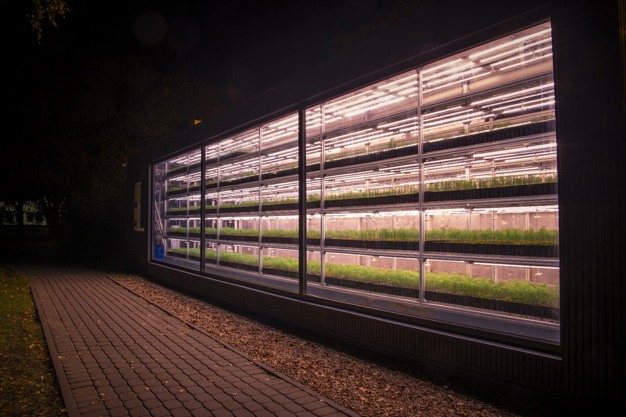Latvia-based Carbon Less Future (CLF) is building a new model for reforestation, one shipping container at a time. Their container-based tree-growing system, designed around vertical farming principles, can cultivate up to 33,600 saplings in a single cycle. The system is intended not only to optimize growing conditions but to make reforestation visible, accessible, and verifiable.
More than a mobile nursery
"A lot of companies donate money to plant trees, but never see them grow. We wanted to change that," says Aigars Jacuks, COO and Co-founder at CLF. Together with CEO and Co-founder Aivis Garais, the team developed a twelve-meter container equipped with a glazed ten-meter wall that allows passersby to observe the growth process in real time.
"The container is more than just a mobile nursery," Jacuks explains. "It's a multi-layered smart farming unit designed for energy efficiency and growth optimization. Each unit includes ten growing levels, five racks per side, and is insulated with six centimeters of food-grade stainless steel. The exterior is clad in thermowood, a durable material selected for both longevity and aesthetics. We wanted it to be beautiful and functional."
Sensor-driven precision growing
Inside, full-spectrum LED lighting simulates sunrise and sunset cycles, while real-time monitoring ensures consistent growing conditions. "Every tier is fitted with sensors to measure temperature, humidity, and soil metrics like volumetric water content and electrical conductivity," says Jacuks. "We use Aranet sensors from SAF Tehnika, some of the most accurate on the market."
Environmental data can be accessed and adjusted through a local LCD interface or remotely via mobile app. "I can monitor CO₂ levels, pH balance, and water conductivity directly from my phone," he adds. The unit operates year-round and uses up to 90 percent less water thanks to an internal recirculation system. Containers can also be equipped with solar panels and rainwater collection systems to further improve sustainability.
Engineering through experimentation
CLF's approach to vertical tree farming was developed through trial and error. "We thought it would be simple at first," Jacuks reflects. "But unlike leafy greens, where there's a lot of available knowledge and precedent, we had to figure everything out ourselves."
"Every floor in the container behaves differently, and unlike traditional nurseries, where everything is planted on the ground, we had to learn how to manage vertical airflow and optimize conditions at each level."
The company worked closely with Latvian researchers from the Institute Silava to develop lighting and airflow systems suited to tree species. After several trials, CLF has successfully planted pine saplings grown in its prototype container into Latvian forests. "Compared to traditional nurseries, we see growth that is two to three times faster," says Jacuks. "And the survival rate over winter has been excellent."
A scalable model for reforestation
Each container is mobile and can be placed wherever electricity and water are available. "We're currently testing additional species like birch, but we can customize the system to grow anything the client needs," he says.
CLF envisions a modular future for the technology. "You can link containers together, but if you want to grow at much larger volumes, then a dedicated facility might make more sense. The container is best used where visibility, education, and space efficiency are priorities."
Bringing forestry to corporate campuses
What makes CLF's approach distinctive is its hybrid role as both a growing system and a corporate sustainability tool. "We're not here to sell trees," says Jacuks. "We're here to help companies make a real, visible contribution to nature."
Companies can rent or purchase containers for their premises, with CLF offering full-cycle maintenance and support, from planting to handover. The system also supports ESG reporting and alignment with EU Taxonomy regulations.
For Jacuks, the value is in engagement as much as growth. "Employees can see the trees growing every day. And when it's time to plant them, they can take part in that too. It's not greenwashing, it's tangible action."
For more information:
Carbon Less Future ![]()
Aigars Jacuks, COO and Co-founder
[email protected]
www.clf.earth
